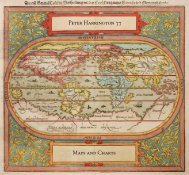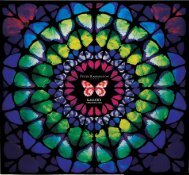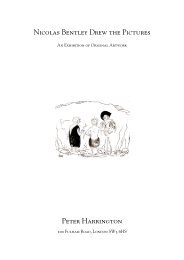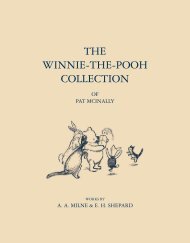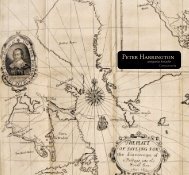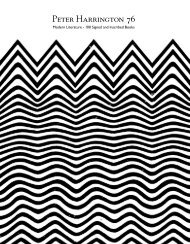antiquarian bookseller - Peter Harrington
antiquarian bookseller - Peter Harrington
antiquarian bookseller - Peter Harrington
You also want an ePaper? Increase the reach of your titles
YUMPU automatically turns print PDFs into web optimized ePapers that Google loves.
<strong>Peter</strong> <strong>Harrington</strong> Antiquarian Bookseller<br />
136.(SMET, Pierre-Jean de)<br />
CHITTENDEN, Hiram<br />
Martin, & Alfred Talbot<br />
Richardson (eds).<br />
Life, Letters and Travels of Father<br />
Pierre-Jean De Smet, S.J. 1801-<br />
1873. Missionary Labors and<br />
Adventures among the Wild Tribes<br />
of the North American Indians,<br />
Embracing Minute Description of<br />
their Manners, Customs, Games,<br />
Modes of Warfare and Torture,<br />
Legends, Traditions. Edited from the<br />
Original Unpublished Manuscript,<br />
Journals, Letter Books and from<br />
his Printed Works with Historical,<br />
Geographical, Ethnological and<br />
other Notes; Also a Life of Father De<br />
Smet.<br />
New York, Francis P. Harper, 1905 [40114] £575<br />
4 volumes, 8vo. Original dark green vertical fine-ribbed cloth,<br />
title gilt to spines. Frontispiece to each and 12 other plates,<br />
folding map in end-pocket to Volume IV. Hinges of vols. I & IV<br />
cracking, indistinct splash mark to upper board of vol. IV, but<br />
overall a very good set.<br />
FIRST EDITION. The Jesuit Father De Smet’s Life provides<br />
an overview of his life and travels among Western Indian<br />
tribes from 1838–70. His journals and notes contain<br />
some of the earliest records of the life and customs of<br />
tribal life in the Northwest.<br />
Howes C392; Howgego S29.<br />
137.STEDMAN, John Gabriel.<br />
Narrative of a five years’ expedition,<br />
against the Revolted Negroes of<br />
Surinam, in Guiana, on the Wild<br />
Coast of South America; from the<br />
year 1772, to 1777: elucidating<br />
the History of that Country, and<br />
describing its Productions, Viz.<br />
Quadrupeds, Birds, Fishes, Reptiles,<br />
Trees, Shrubs, Fruits, & Roots; with<br />
an account of the Indians of Guiana,<br />
& Negroes of Guinea … illustrated<br />
with 80 elegant Engravings, from<br />
drawings made by the Author.<br />
London, for J. Johnson, & J. Edwards, 1796 [32103] £4500<br />
2 volumes, 4to (264 × 210 mm). 8pp. list of subscribers, 2pp.<br />
errata. Contemporary half calf, black morocco labels, thickand-thin<br />
gilt rules either side of raised bands, marbled boards.<br />
Engraved titles with integral vignettes, frontispiece and 80<br />
plates and maps (including 16 by William Blake, 3 folding<br />
maps, one folding aquatint plate). Lightly rubbed, a little very<br />
light marginal spotting to plates, an excellent copy.<br />
FIRST EDITION of one of the most detailed descriptions<br />
ever written of an 18th-century slave plantation society,<br />
describing the full panorama of colonial life – the<br />
mistreatment of slaves by sadistic masters, the courage of<br />
the rebels in battle, the daily lives of Indian and African<br />
slaves, and exotic flora and fauna. John Gabriel Stedman<br />
(1744–1797), a soldier of Scottish-Dutch descent,<br />
responded to a call for volunteers to put down a slave<br />
rebellion in the wealthy South American colony of Surinam.<br />
He wrote from a position of unusually close engagement,<br />
having entered a form of marriage soon after his arrival<br />
with Joanna, a 15-year-old mixed-race slave, who<br />
bore him a son. Belying his radical reputation, Johnson<br />
employed a professional editor to tone down Stedman’s<br />
antislavery views, but the Narrative still had massive<br />
contemporary impact. Upon its publication the Critical<br />
Review observed that ‘we have never opened any work<br />
which is so admirably calculated to excite the most heart-<br />
felt abhorrence and detestation of that grossest assault<br />
on human nature – domestic slavery’ (January 1797, 53).<br />
Among the engravers was William Blake, “responsible for<br />
sixteen plates that ‘have long been recognized as among<br />
the best executed and most generally interesting of all his<br />
journeyman work’ (Keynes, 98). Each of Blake’s arresting<br />
engravings successfully blends his own inner vision with<br />
Stedman’s. The often-reproduced slave tortures (pl. 11,<br />
35, 71) convey extraordinary power and pathos, the<br />
wonderfully humanoid monkeys and the skinning of the<br />
giant anaconda (pl. 18, 42, 19) sprightly humour, and his<br />
emblematic representation of Europe Supported by Africa<br />
& America (pl. 80) demure but unmistakable sensuality”<br />
(ODNB).<br />
138.WALLACE, Alfred W.<br />
A Narrative of Travels on the<br />
Amazon and Rio Negro, with an<br />
Account of the Native Tribes, and<br />
Observations on the Climate,<br />
Geology, and Natural History of the<br />
Amazon Valley.<br />
London, Reeve and Co., 1853 [39385] £2250<br />
8vo. (228 × 146mm). Slightly later half morocco on marbled<br />
boards, title gilt to spine, pomegranate devices gilt to the<br />
compartments. Tinted lithographic frontispiece, 8 plates,<br />
folding table and a map. Ex-Repton School library with<br />
bookplate to the front pastedown and ink stamp to the<br />
title page, some transference to margin of frontispiece,<br />
some marginal foxing and browning, but overall very good,<br />
rebacked with the original spine laid down.<br />
FIRST EDITION. An entirely autodidact naturalist, inspired<br />
by Edwards’s Voyage up the River Amazon, Wallace set<br />
off in 1848 for the Amazon with Walter Henry Bates, an<br />
enthusiastic entomologist, “Apart from meeting their<br />
immediate goal of earning a living through natural<br />
history collecting, Wallace and Bates had a broader<br />
purpose for travelling to the Amazon: solving the mystery<br />
of the causes of organic evolution. Though Wallace had<br />
unreservedly embraced the notion of social progress<br />
from his early teens and apparently leaned toward<br />
a uniformitarianism-based but progressive view of<br />
change in physical nature even before turning twenty,<br />
he had not been a convert to biological evolution until<br />
he read Robert Chambers’s controversial, anonymously<br />
published Vestiges of the Natural History of Creation<br />
about 1845, the year it was published. That one might<br />
demonstrate the fact of evolution through a detailed<br />
tracing out of individual phylogenies over time and<br />
space was apparent to him early on, and the Amazon<br />
was to afford a natural laboratory to this end” (ODNB).<br />
Wallace followed this with a trip to the Malay Archipelago<br />
and in 1855 his paper “On the Law which has regulated<br />
the Introduction of New Species” written whilst he was<br />
at Sarawak was noticed by Lyell who drew it to Darwin’s<br />
attention. The result was a joint presentation of Wallace<br />
Catalogue 57: Travel Section 3: The Americas, Greenland and the Arctic<br />
and Darwin’s findings on natural selection at the Linnaean<br />
Society in 1858. An important and uncommon work.<br />
Borba de Moraes, p. 933<br />
139.WATERTON, Charles.<br />
Wanderings in South America, the<br />
North-West of the United States,<br />
and the Antilles, in the Years<br />
1812, 1816, 1820, and 1824. With<br />
Original Instructions for the Perfect<br />
Preservation of Birds, &c. for<br />
Cabinets of Natural History.<br />
London, J. Mawman, 1825 [38006] £450<br />
4to. (282 × 212 mm). Engraved frontispiece of a “Nondescript”.<br />
Armorial bookplate of John Selwin to front pastedown.<br />
Frontispiece foxed as usual and slightly off-set onto title page,<br />
a little scattered foxing, but on the whole a very good copy<br />
in contemporary tan calf with dark green morocco lettering<br />
piece, a little rubbed, upper joint slightly cracked, head-cap<br />
chipped,.<br />
FIRST EDITION. An extremely engaging and consequently<br />
highly popular travel narrative, including the pursuit of<br />
samples of curare in Dutch Guiana and the hunt for El<br />
Dorado. Probably most remarked upon is the frontispiece<br />
of a “Nondescript”, a “human face based on that of a red<br />
monkey” (ODNB) which had been modelled employing<br />
the Waterton Method of taxidermy.<br />
Howes W158; Sabin 102094.<br />
140.WHYMPER, Edward.<br />
Travels Amongst the Great Andes of<br />
the Equator.<br />
London, John Murray, 1892 [23432] £300<br />
4to. Original green cloth, bevelled boards, spine lettered in<br />
gilt, gilt decorative borders at top and bottom of front cover<br />
running onto spine and in blind on rear cover, brown coated<br />
endpapers, uncut edges. Frontispiece, 19 plates, 4 maps (1<br />
folding map in pocket at end), and illustrations in the text. A<br />
little wear and fading to cloth but overall a very good copy.<br />
FIRST EDITION of what is often considered Whymper’s<br />
magnum opus. Whymper “travelled in 1879–80 to Ecuador<br />
with his former Matterhorn rival J. A. Carrel and the<br />
latter’s cousin Louis Carrel, to test the physiological effects<br />
of low pressure at high altitudes and the phenomenon<br />
of ‘mountain sickness’. They twice climbed Chimborazo<br />
(20,498 feet), the highest mountain in Ecuador, and other<br />
peaks including Cotopaxi (19,613 feet), an active volcano.<br />
Whymper also surveyed the area and collected over<br />
8000 zoological and botanical specimens” (ODNB). The<br />
book combines a popular account of his ascents with his<br />
detailed scientific observations.<br />
141.WORTLEY, Lady<br />
Emmeline Stuart.<br />
Travels in the United States, etc.<br />
during 1849 and 1850.<br />
London, Richard Bentley, 1851 [38029] £750<br />
3 volumes, 8vo. Some browning, particularly to the title<br />
pages, small ink stamps of the NSW Parliamentary Library to<br />
the title pages, but in all other respects a very nice set in the<br />
original blue embossed cloth, titles gilt to spines, very light<br />
shelf-wear.<br />
FIRST EDITION. A prolific poet, friend of Mary Shelley,<br />
Richard Monckton Milnes and Tennyson, and a prodigious<br />
traveller. Following the death of her husband and<br />
youngest son in 1844 she began undertaking a series<br />
of “increasingly punishing” journeys. In 1849–50 she<br />
travelled down through America, into Mexico, across<br />
Panama and down to Peru, accompanied by her 12-yearold<br />
daughter Victoria, who also published an account of<br />
her experiences. Lady Wortley died whilst on a trip across<br />
the Middle East in 1855.



